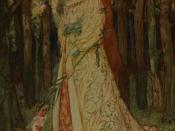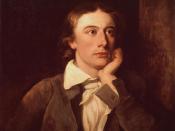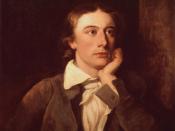Keats's conception of "Melancholy"ÃÂ is that we as humans cannot truly feel joy, unless we have felt true sorrow first. We find this ideal in several of his works; the two I plan to focus on are "Ode to Melancholy"ÃÂ and "La Belle Dame sans Merci: A Ballad"ÃÂ. In his "Ode to Melancholy"ÃÂ, Keats clearly illustrates this idea as one reads through the stanzas.
The first stanza he tells the readers not to deaden their senses with drugs, or to forget their sorrows by going to Lethe. Keats states this to say that we need the sorrow we feel to find true happiness, to be "ÃÂ as Dr. Gurney stated "ÃÂ strong enough to reach for the light of joy, yet live in the shadows of sorrow.
In the next two stanzas, Keats works to show the intertwining of joy and sorrow. He does this by using images such as weeping clouds, droop-headed flowers, a morning rose, rainbows, and peonies.
By combining these elements in the way that Keats does, one gets the idea of the pleasure and pain principle once more; that they go hand in hand, and without feeling one, you cannot truly feel the other.
The final stanza concludes Keats's point. It clearly demonstrates that mortal joy causes pain, because we know it will end; therefore, we constantly chase it. Joy continually eludes us, because "ÃÂ impart "ÃÂ we let it. We are never truly satisfied with anything, not completely; furthermore, we end up finding more sorrow with joy due to the fact that the illustrious feeling we so eagerly anticipated has deteriorated and we are once again faced with the longing to fulfill a desire that seems to be ultimate joy. So in the end, we live our lives to seek joy, knowing that in the end there shall be sorrow.
Again, Keats has clearly shown us his view on "Melancholy"ÃÂ as being simply a curve in life's cycle of joy and sorrow. That everyone who lives must feel one to feel another, and that there is no other way around it; we as humans will seek joy, even though we realize that sorrow will accompany it as well.
In another of Keats's works "ÃÂ "La Belle Dame sans Merci: A Ballad"ÃÂ "ÃÂ we once again find "Melancholy"ÃÂ and it serves the same purpose once more. A story of a knight, a sylvan woman, and the sorrow he finds in the pleasure he holds.
Keats begins with a knight asking himself what troubles him. As he wanders he states that "the squirrel's granary is full, and the harvest is done,"ÃÂ which in turn shows us that while everything he wanted is done, yet he still hungers for joy. Further into the woods he travels, upon where he meets a lady of the woods. She is beautiful and innocent. This is the point where the experienced knight finds the innocent lady; experience is representing sorrow, innocence represents joy. He goes on to tell how he wooed the woman and they made love. In the aftermath, the woman cries. She realizes that her innocence has left her. That joy has passed to sorrow. The knight to experiences sorrow after the eminent joy of lovemaking. In his dreams he sees haunting visions of war and death "ÃÂ perhaps representing his fear of settling down and raising a family, only to lose them to war. Then he awakes and leaves his lady and sits upon the lakeside.
Once more Keats has demonstrated how joy and sorrow go hand in hand. One can find a relationship with "Melancholy"ÃÂ in other Keats works as well, but these two odes demonstrate the cycle of joy and sorrow the way I believe Keats viewed them - in my mind, the way they truly are.





